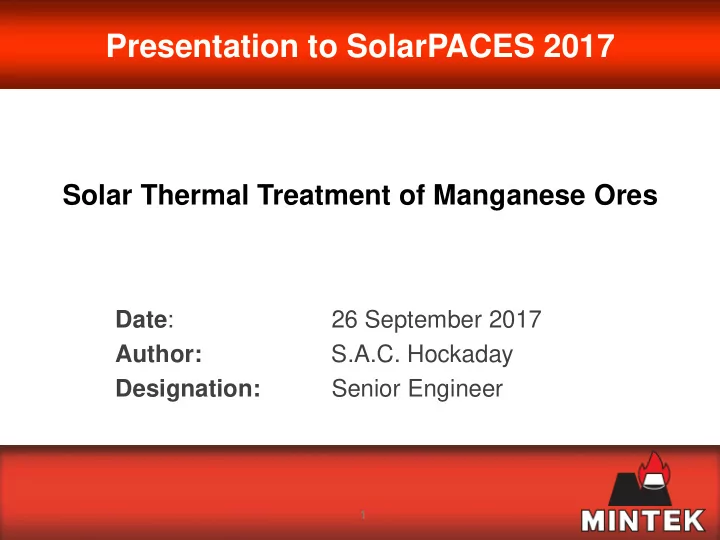

Presentation to SolarPACES 2017 Solar Thermal Treatment of Manganese Ores Date : 26 September 2017 Author: S.A.C. Hockaday Designation: Senior Engineer 1
MINTEK Mineral Minerals Economics Processing and Strategy Analytical Hydrometallurgy Small Scale Science Mining and Advanced Mineralogy Beneficiation Materials Measurement Pyrometallurgy and Control Biotechnology 2
Manganese ore processing – current landscape Mining 18.5 Mt/a ore (2015) Lumpy product Sizing and classification Ferromanganese alloys, 4.9 Mt/a alloy Dense medium Sintered product separation Slag Smelters 2.8 MWh/t HCFeMn Sinter plant Air 3.9 MWh/t SiMn Fuel Reductant and/or fuel Fluxes Carbon Figure 1 . Manganese ore processing 3
Manganese ore processing – future landscape? Mining Lumpy product Sizing and classification Ferromanganese alloys Preheating and pre- Dense medium Upgrading of Sintered product reduction marginal ores separation Slag Pelletising Smelters that Sintering Sinter plant accept fines Air Briquetting Fuel Alternative reductants Fluxes Carbon Figure 2 . Manganese ore processing tomorrow 4
Experiments Figure 4. Untreated ore , -6 mm Figure 5. Pellets, -13 mm + 6 mm Figure 3. STERG solar concentrator 5
Experimental Set-up – Sample container Figure 7. Empty sample container x = 50 mm x = 25 mm x = 0 mm Figure 8. Full sample container Figure 6. Positions of central thermocouples 6
Results - Thermal Figure 9. Temperatures recorded, Pellets B + 7
Assumptions – Heat Transfer Modelling The assumptions made for the present model include: • Approximation of the bed as a continuum slab of material with constant and uniform thermal conductivity, effective density, and heat capacity. • Approximation of the heat transfer mechanism in the bed as one-dimensional (perpendicular to hot face) and transient. A single “concentration factor” , h , expressing the concentration ratio between • the measured instantaneous direct normal insolation (DNI) and the energy flux experienced at the bed hot face. • A boundary condition at the hot face expressed in terms of a convective heat transfer coefficient and a surface emissivity, both pre-specified constants. 8
Results of Heat Transfer Model Figure 10. Experimental temperatures and model predicted temperatures 9
Effective Thermal Conductivity k (manganese ores) = 0.5 – 4 W/(m . K) Ksiazek, 2012 k air = 0.02 – 0.06 W/(m . K) k graphite = 25 – 470 W/(m . K) Figure 11. Effective thermal conductivities 10
Effective concentration ratio Figure 12. Effective concentration factors 11
Thermodynamic Modelling Figure 13. Thermodynamic equilibrium model - A 12
Thermodynamic Modelling Figure 13. Thermodynamic equilibrium model - A 13
Thermodynamic Modelling Figure 14. Thermodynamic equilibrium model - B 14
Thermodynamic Modelling Figure 14. Thermodynamic equilibrium model - B 15
Thermodynamic Modelling Figure 15. Thermodynamic equilibrium model - C 16
Thermodynamic Modelling Figure 15. Thermodynamic equilibrium model - C 17
Future studies • Modify set-up to investigate forced convection • Take measures to improve concentrator efficiency • Expand heat transfer model to include chemical reactions and variable convection • Review implications of results on economic model Figure 16. How to avoid sunburn 18
Conclusions • Heating and thermal decomposition of manganese ores has been demonstrated • Effective thermal conductivities has been determined for test materials in air • The effective concentration ratio has been determined for the concentrator • Empirical results when compared to thermodynamic equilibrium models indicate that kinetics factors are limiting decomposition • Organic content in ore C facilitated higher mass loss by acting as a reductant 19
Acknowledgements • MINTEK • STERG • Southern African Universities Radiometric Network, SAURAN • Transalloys Figure 17. SAURAN station on adjacent rooftop M.J. Brooks, S. du Clou, J.L. van Niekerk, P. Gauche, C. Leonard, M.J. Mouzouris, A.J. Meyer, N. van der Westhuizen, E.E. van Dyk, and F. Vorster. Sauran: A new resource for solar radiometric data in southern africa. Journal of Energy in Southern Africa , 26:2 – 10, 2015. 20
Thank You www.mintek.co.za http://www.mintek.co.za/technical- divisions/pyrometallurgy-pdd/ Twitter: @Mintek_RSA LinkedIn: https://za/linkedin.com/company/mintek 21
Recommend
More recommend